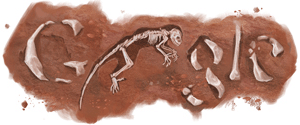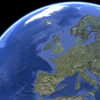Saturday, May 30, 2009
Google Sightseeing
Google just beefed up G_SATELLITE_3D_MAP!
Google just ( May 29, 2009 ) announced a completely rewritten and 'beefed up' G_SATELLITE_3D_MAP (see Figure 2), available now in the latest experimental version of the Maps API (currently 2.160). While the usage is the same (simply use the line of code above), the overlay/feature synchronization is much more extensive, the 2D/3D transitioning is seamless, and the overall Maps/Earth integration is much stronger.
Most common Maps API overlays are now supported: markers, polylines, polygons, ground overlays, screen overlays, and even GGeoXml objects are automatically mirrored in the Google Earth Plugin. In fact, GGeoXml works in an especially powerful way: although Maps may not display all KML from a GGeoXml (i.e. 3D models), the Earth Plugin will show all the content, in all its 3D glory.
Beefed up G_SATELLITE_3D_MAP
Search results labeled 'This site may harm your computer'
If you click the title of the result, you'll be shown the warning rather than being taken immediately to the webpage in question. You can choose to continue to the site at your own risk.
more details in Google, visit here.
Friday, May 29, 2009
Fill in the blanks (*)
Search within a specific website (site:)
Google Phrase search ("")
By putting double quotes around a set of words, you are telling Google to consider the exact words in that exact order without any change. Google already uses the order and the fact that the words are together as a very strong signal and will stray from it only for a good reason, so quotes are usually unnecessary. By insisting on phrase search you might be missing good results accidentally. For example, a search for [ "Alexander Bell" ] (with quotes) will miss the pages that refer to Alexander G. Bell.
Thursday, May 28, 2009
Search with boolean operators
AND(+): The AND operator forces Google to match the search results against all your keywords. The operator is signified by a plus sign (+). Place the plus sign immediately before any words without a space, for example: Google +search
NOT(-): The NOT operator excludes words. The symbol is a minus sign (-). Place the symbol immediately before a word.
for example: Google -search
OR: The OR operator is helpful when using obscure keywords that might not return much of value if used singly. It also neatly divides a search along two concurrent avenues of exploration. Simply type OR (use capital letters) before a keyword and leave a space between the operator and the following keyword. Google then accepts matches to the keyword preceding the operator or following the operator.
for example: Google Android Maps OR Earth
Tuesday, May 26, 2009
Google App Engine

Easy to build, easy to maintain, easy to scale.
Google App Engine Home
Google App Engine lets you run your web applications on Google's infrastructure. App Engine applications are easy to build, easy to maintain, and easy to scale as your traffic and data storage needs grow. With App Engine, there are no servers to maintain: You just upload your application, and it's ready to serve your users.
Know more about What Is Google App Engine?
Monday, May 25, 2009
Google Mobile
Google products for your phone
Stay connected on the go with Gmail, Search, Maps and other Google products. Check below to find out which products are available for your phone.
or visit m.google.com from your phone
Friday, May 22, 2009
Ajax, Google Maps and MyEclipse

This is a demonstration that showcases the power of Eclipse-based technology through the use of advanced Ajax tooling and interaction with one of the Web's most popular API's, Google Maps.
Total running time is 10:00 minutes
Today Google logo: Mary Cassatt's Birthday

Mary Stevenson Cassatt (May 22, 1844 – June 14, 1926) (pronounced [kəˈsæt]) was an American painter and printmaker. She lived much of her adult life in France, where she first befriended Edgar Degas and later exhibited among the Impressionists.
Cassatt often created images of the social and private lives of women, with particular emphasis on the intimate bonds between mothers and children.
from "Mary Cassatt - Wikipedia, the free encyclopedia"
Thursday, May 21, 2009
Google Chrome: a new web browser for Windows

Wednesday, May 20, 2009
Android 1.5 SDK is now available

The final version of the Android 1.5 SDK is now available. It includes new APIs for Android 1.5, updated developer tools, multiple platform versions, and a Google APIs add-on.
Android Developers
Today Google logo: Scientists unveil fossil of Darwinius masillae

"MISSING LINK" FOUND: New Fossil Links Humans, Lemurs?
May 19, 2009—Meet "Ida," the small "missing link" found in Germany that's created a big media splash and will likely continue to make waves among those who study human origins.
In a new book, documentary, and promotional Web site, paleontologist Jorn Hurum, who led the team that analyzed the 47-million-year-old fossil seen above, suggests Ida is a critical missing-link species in primate evolution (interactive guide to human evolution from National Geographic magazine).
(Among the team members was University of Michigan paleontologist Philip Gingerich, a member of the Committee for Research and Exploration of the National Geographic Society, which owns National Geographic News.)
The fossil, he says, bridges the evolutionary split between higher primates such as monkeys, apes, and humans and their more distant relatives such as lemurs.
"This is the first link to all humans," Hurum, of the Natural History Museum in Oslo, Norway, said in a statement. Ida represents "the closest thing we can get to a direct ancestor."
Ida, properly known as Darwinius masillae, has a unique anatomy. The lemur-like skeleton features primate-like characteristics, including grasping hands, opposable thumbs, clawless digits with nails, and relatively short limbs.
"This specimen looks like a really early fossil monkey that belongs to the group that includes us," said Brian Richmond, a biological anthropologist at George Washington University in Washington, D.C., who was not involved in the study.
But there's a big gap in the fossil record from this time period, Richmond noted. Researchers are unsure when and where the primate group that includes monkeys, apes, and humans split from the other group of primates that includes lemurs.
"[Ida] is one of the important branching points on the evolutionary tree," Richmond said, "but it's not the only branching point."
At least one aspect of Ida is unquestionably unique: her incredible preservation, unheard of in specimens from the Eocene era, when early primates underwent a period of rapid evolution. (Explore a prehistoric time line.)
"From this time period there are very few fossils, and they tend to be an isolated tooth here or maybe a tailbone there," Richmond explained. "So you can't say a whole lot of what that [type of fossil] represents in terms of evolutionary history or biology."
In Ida's case, scientists were able to examine fossil evidence of fur and soft tissue and even picked through the remains of her last meal: fruits, seeds, and leaves.
What's more, the newly described "missing link" was found in Germany's Messel Pit. Ida's European origins are intriguing, Richmond said, because they could suggest—contrary to common assumptions—that the continent was an important area for primate evolution.
from National Geographic-"MISSING LINK" FOUND: New Fossil Links Humans, Lemurs?
Android
Developed by the Open Handset Alliance, Android brings Internet-style innovation and openness to mobile phones.
Android™ delivers a complete set of software for mobile devices: an operating system, middleware and key mobile applications.
http://www.android.com/
Sunday, May 17, 2009
GPicSync, automatically inserts location in your photos metadata.
GPicSync automatically inserts location in your photos metadata so they can also be used with any 'geocode aware' application like Picasa/Google Earth, Flickr, loc.alize.us, etc.
Features:
- automatically geocode your photos (in the EXIF header)
- use a GPS tracklog in the GPX format or NMEA format (multiple selection possible)
- Support elevation data if present in the tracklog
- create a Google Earth KML file to directly visualize the geocoded photos and track in Google Earth
- create a Google Maps file to publish your pictures and track on the web (more)
- Automatically associate audio or video files in Google Earth and Google Maps
- create a Google Earth KMZ file (containing your geolocalized pictures and tracklog).
- add additional geonames and 'geotagged' metadata (for automatic tagging in Flickr for example) and create an automatic IPTC caption (more)
- manually write latitude/longitude in a picture EXIF or a selection of photos
- handy tools integrated (Time correction tool, EXIF reader, GPX inspector, rename pictures with date/location,)
- supports Jpeg pictures and main RAW files format (more)
- software available in English, French, German, Italian, traditional and simplified Chinese, Catalan, Russian, Spanish, Polish, Portuguese and Czech (see translations)
note:
April 13th 2009 : New version 1.28 beta available
Saturday, May 16, 2009
Google Maps
- Integrated business search results - Find business locations and contact information all in one location, integrated on the map. For example, if you search for [ pizza in San Jose, CA ], locations of relevant listings and phone numbers appear on the map. You can also view additional information like hours of operation, types of payment accepted, and reviews.
- Draggable maps - Click and drag maps to view adjacent sections instantly (no long waits for new areas to download).
- Satellite imagery - View a satellite image (or a satellite image with superimposed map data) of your desired location that you can zoom and pan.
- Terrain maps - View physical features, such as mountains and vegetation, with elevation shading.
- Street View - View and navigate within street-level imagery.
- Detailed directions - Enter an address and let Google Maps plot the location and driving directions for you. Plan a trip by adding multiple destinations to your route, and click and drag the route to customize it. Learn more about Google Maps driving directions.
- Keyboard shortcuts - Pan left, right, up and down with the arrow keys. Pan wider with the Page Up, Page Down, Home and End keys. Zoom in and out with the plus (+) and minus (-) keys.
- Double-click to zoom functionality - Double left-click to zoom in, and double right-click to zoom out (Ctrl+ double-click for Mac users).
- Scroll wheel zooming - Use the scroll wheel on your mouse to zoom in and out of the maps.
http://maps.google.com/
Google Earth

Google Earth lets you fly anywhere on Earth to view satellite imagery, maps, terrain, 3D buildings, from galaxies in outer space to the canyons of the ocean. You can explore rich geographical content, save your toured places, and share with others.
http://earth.google.com/
Friday, May 15, 2009
Googleplex
View Larger Map

